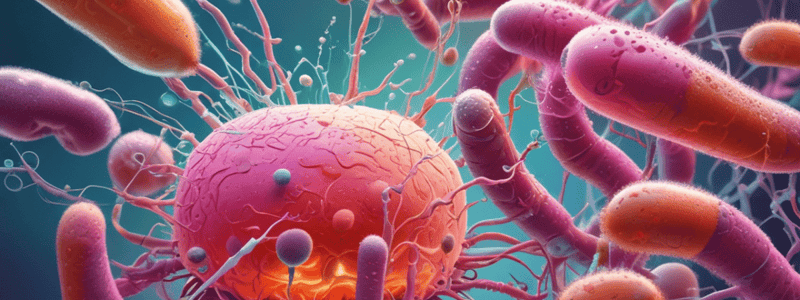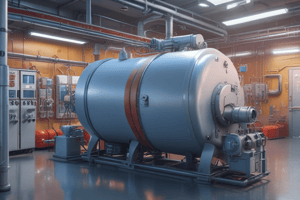Podcast
Questions and Answers
What temperature range is used in the holder method for sterilization?
What temperature range is used in the holder method for sterilization?
- 63°C - 66°C (correct)
- 100°C - 110°C
- 72°C - 75°C
- 50°C - 60°C
What is the purpose of the Tyndallization method?
What is the purpose of the Tyndallization method?
- To achieve immediate sterilization
- To ensure complete sterility in a single exposure
- To eliminate spores on the 1st day
- To kill vegetative organisms on the 2nd day (correct)
What is a limitation of boiling as a sterilization method?
What is a limitation of boiling as a sterilization method?
- Ineffective against spores (correct)
- Primarily used for vaccine preparation
- Ensures complete sterility in one cycle
- Destroys all microbial life forms
In the flash method, at what temperature is sterilization achieved?
In the flash method, at what temperature is sterilization achieved?
Which physical method is the principal method for sterilizing heat-labile materials?
Which physical method is the principal method for sterilizing heat-labile materials?
Which of the following is NOT an agent that denatures proteins?
Which of the following is NOT an agent that denatures proteins?
What is the primary mechanism by which alcohols exert their antimicrobial activity?
What is the primary mechanism by which alcohols exert their antimicrobial activity?
Which of the following is the primary mechanism by which halogens, such as chlorine and iodine, act as antimicrobials?
Which of the following is the primary mechanism by which halogens, such as chlorine and iodine, act as antimicrobials?
What is the primary mechanism of action of silver nitrate as an antimicrobial agent?
What is the primary mechanism of action of silver nitrate as an antimicrobial agent?
Which of the following is the most effective antimicrobial agent against viruses?
Which of the following is the most effective antimicrobial agent against viruses?
What is the primary mechanism of action of household bleach (sodium hypochlorite) as an antimicrobial agent?
What is the primary mechanism of action of household bleach (sodium hypochlorite) as an antimicrobial agent?
What is the main difference between an autoclave and a hot air sterilizer?
What is the main difference between an autoclave and a hot air sterilizer?
What is the primary purpose of autoclaving in sterilization?
What is the primary purpose of autoclaving in sterilization?
Why is autoclave control essential in the sterilization process?
Why is autoclave control essential in the sterilization process?
What is the significance of the dark color change in the Bowie Dick Method?
What is the significance of the dark color change in the Bowie Dick Method?
What distinguishes pasteurization from sterilization?
What distinguishes pasteurization from sterilization?
In what way does an autoclave differ from a steam-jacketed autoclave?
In what way does an autoclave differ from a steam-jacketed autoclave?
Which disinfectant is 10 times more effective than formaldehyde?
Which disinfectant is 10 times more effective than formaldehyde?
Which type of item is Glutaraldehyde commonly used to disinfect?
Which type of item is Glutaraldehyde commonly used to disinfect?
What is a common use of formaldehyde mentioned in the text?
What is a common use of formaldehyde mentioned in the text?
Which organism is NOT mentioned to be effectively targeted by phenols and their derivatives?
Which organism is NOT mentioned to be effectively targeted by phenols and their derivatives?
What makes glutaraldehyde an ideal disinfectant for critical items used in invasive procedures according to the text?
What makes glutaraldehyde an ideal disinfectant for critical items used in invasive procedures according to the text?
Which of the following is NOT a method of high-level disinfection according to the text?
Which of the following is NOT a method of high-level disinfection according to the text?
What is the purpose of using a cotton wool plug in tubes during the filtration of air?
What is the purpose of using a cotton wool plug in tubes during the filtration of air?
Which type of filter is composed of compressed asbestos?
Which type of filter is composed of compressed asbestos?
What is the main function of Gamma radiation and X-rays when used for sterilization?
What is the main function of Gamma radiation and X-rays when used for sterilization?
Which radiation type absorbs water molecules and then releases microwave energy as heat?
Which radiation type absorbs water molecules and then releases microwave energy as heat?
What is the purpose of a Berkefield filter?
What is the purpose of a Berkefield filter?
What is the range of wavelengths for Ultraviolet light used to reduce the number of micro-organisms in air?
What is the range of wavelengths for Ultraviolet light used to reduce the number of micro-organisms in air?
Flashcards
Holder method
Holder method
A sterilization method that uses a temperature range of 63°C to 66°C.
Tyndallization method
Tyndallization method
A method designed to kill vegetative organisms on the second day of treatment.
Limitation of boiling sterilization
Limitation of boiling sterilization
Boiling water is not effective against spores, which are resistant to high temperatures.
Flash method temperature
Flash method temperature
Signup and view all the flashcards
Sterilization of heat-labile materials
Sterilization of heat-labile materials
Signup and view all the flashcards
Antimicrobial effect of heavy metals
Antimicrobial effect of heavy metals
Signup and view all the flashcards
Mechanism of alcohol action
Mechanism of alcohol action
Signup and view all the flashcards
Halogen antimicrobial action
Halogen antimicrobial action
Signup and view all the flashcards
Silver nitrate antimicrobial action
Silver nitrate antimicrobial action
Signup and view all the flashcards
Most effective antiviral agent
Most effective antiviral agent
Signup and view all the flashcards
Household bleach antimicrobial action
Household bleach antimicrobial action
Signup and view all the flashcards
Autoclave vs. hot air sterilizer
Autoclave vs. hot air sterilizer
Signup and view all the flashcards
Autoclaving purpose
Autoclaving purpose
Signup and view all the flashcards
Autoclave control
Autoclave control
Signup and view all the flashcards
Bowie Dick test
Bowie Dick test
Signup and view all the flashcards
Pasteurization vs. sterilization
Pasteurization vs. sterilization
Signup and view all the flashcards
Autoclave types
Autoclave types
Signup and view all the flashcards
Glutaraldehyde effectiveness
Glutaraldehyde effectiveness
Signup and view all the flashcards
Glutaraldehyde use
Glutaraldehyde use
Signup and view all the flashcards
Formaldehyde use
Formaldehyde use
Signup and view all the flashcards
Phenol effectiveness
Phenol effectiveness
Signup and view all the flashcards
Glutaraldehyde ideal for critical items
Glutaraldehyde ideal for critical items
Signup and view all the flashcards
High-level disinfection methods
High-level disinfection methods
Signup and view all the flashcards
Cotton wool plug function
Cotton wool plug function
Signup and view all the flashcards
Seitz filter composition
Seitz filter composition
Signup and view all the flashcards
Radiation sterilization mechanism
Radiation sterilization mechanism
Signup and view all the flashcards
Microwave radiation sterilization
Microwave radiation sterilization
Signup and view all the flashcards
Berkefield filter function
Berkefield filter function
Signup and view all the flashcards
UV light sterilization
UV light sterilization
Signup and view all the flashcards




